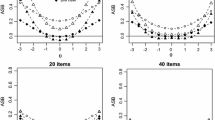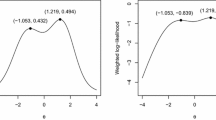Abstract
The simultaneous and nonparametric estimation of latent abilities and item characteristic curves is considered. The asymptotic properties of ordinal ability estimation and kernel smoothed nonparametric item characteristic curve estimation are investigated under very general assumptions on the underlying item response theory model as both the test length and the sample size increase. A large deviation probability inequality is stated for ordinal ability estimation. The mean squared error of kernel smoothed item characteristic curve estimates is studied and a strong consistency result is obtained showing that the worst case error in the item characteristic curve estimates over all items and ability levels converges to zero with probability equal to one.
Similar content being viewed by others
References
Billingsley, P. (1986).Probability and measure. New York: Wiley.
Bock, R. D., & Aitkin, M. (1981). Marginal maximum likelihood estimation of item parameters: Application of an EM algorithm.Psychometrika, 46, 443–459.
Devroye, L. P. (1978). The uniform convergence of the Nadaraya-Watson regression function Estimate.Canadian Journal of Statistics, 6, 179–191.
Fan, J., & Truong, Y. K. (1993). Nonparametric regression with errors in variables.The Annals of Statistics, 21, 1900–1925.
Haberman, S. J. (1977). Maximum likelihood estimates in exponential response models.Annals of Statistics, 5, 815–841.
Härdle, W. (1990).Applied nonparametric regression. Cambridge: Cambridge University Press.
Hastie, T. J., & Tibshirani, R. J. (1990).Generalized additive models. London: Chapman Hall.
Hoeffding, W. (1986). Probability inequalities for sums of bounded random variables.Encyclopedia of Statistical Sciences, 7, 222–225.
Nadaraya, E. A. (1964). On estimating regression.Probability Theory and Its Applications, 9, 141–142.
Neyman, J., & Scott, E. L. (1948). Consistent estimates based on partially consistent observations.Econometrika, 16, 1–32.
Ramsay, J. O. (1991). Kernel smoothing approaches to nonparametric item characteristic curve estimation.Psychometrika, 56, 611–630.
Ramsay, J. O. (1994).TESTGRAF: A program for the graphical analysis of multiple choice test and questionnaire data. Unpublished user's guide to TESTGRAF.
Ramsay, J. O., & Winsberg, S. (1991). Maximum marginal likelihood estimation for semiparametric item analysis.Psychometrika, 56, 365–379.
Samejima, F. (1979).A new family of models for the multiple-choice item (Research report No. 79-4). Knoxville, TN: University of Tennessee, Department of Psychology.
Samejima, F. (1981).Efficient methods of estimating the operating characteristic of item response categories and challenge to a new model for the multiple-choice item. Unpublished manuscript, Knoxville, TN: University of Tennessee, Department of Psychology.
Samejima, F. (1984).Plausibility functions of the Iowa Vocabulary Test items estimated by the simple sum procedure of the conditional P.D.F.approach (Research report No. 84-1). Knoxville, TN: University of Tennessee, Department of Psychology.
Samejima, F. (1988).Advancement of latent trait theory (Research Report No. 79-4). Knoxville, TN: University of Tennessee, Department of Psychology.
Samejima, F. (1990).Differential weight procedure of the conditional p.d.f.approach for estimating the operating characteristic of discrete item responses (ONR research report No. 90-4). Knoxville, TN: University of Tennessee, Department of Psychology.
Schuster, E. F. (1972). Joint asymptotic distribution of the estimated regression function at a finite number of distinct points.Annals of Mathematical Statistics, 43, 84–88.
Serfling, R. J. (1980).Approximation theorems of mathematical statistics. New York: John Wiley.
Watson, G. S. (1964). Smooth regression analysis.Sankhya, Series A, 26, 359–372.
Wingersky, M. S., Patrick, R., & Lord, F. M. (1988).LOGIST User's Guide. Princeton, New Jersey: Educational Testing Service.
Author information
Authors and Affiliations
Rights and permissions
About this article
Cite this article
Douglas, J. Joint consistency of nonparametric item characteristic curve and ability estimation. Psychometrika 62, 7–28 (1997). https://doi.org/10.1007/BF02294778
Received:
Revised:
Issue Date:
DOI: https://doi.org/10.1007/BF02294778




